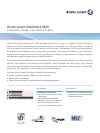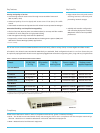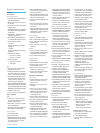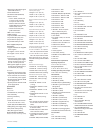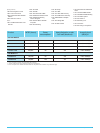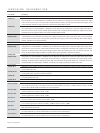
Alcatel-Lucent OmniSwitch 6400 | Data Sheet 3
P
roduct specifications
Features
P
erformance
Interfaces and speeds
• 24 and 48 ports 10/100/1000, 24
ports 100/1000BaseX
• Wire rate at layer 2 and layer 3
on all ports
• Two built-in 10 Gbps full-duplex
stacking ports
• OS6400-24, -P24, -48, -P48 support
four Gigabit Ethernet (GigE) SFP
combo ports
• OS6400-U24, -U24D support two
GigE SFP combo ports
• PoE: IEEE 802.3af supported on
“P” PoE models (15.4 W per port)
• Raw switching capacity:
¬ 24 port:
48 Gbps full duplex or 96 Gbps
aggregate
¬ 48 port:
96 Gbps full duplex or 192 Gbps
aggregate
• Switching throughput:
¬ 24 port: 35.7 Mpps
¬ 48 port: 71.4 Mpps
• Stacking capacity:
¬ 2x10 Gig full duplex
¬ 29.8 Mpps
Q
oS
• Priority queues: eight hardware-
based queues per port
• Traffic prioritization: Flow-based
QoS with internal and external
(a.k.a., re-marking) prioritization
• Bandwidth management: flow-
based bandwidth management,
ingress policing shaping and
port-based egress shaping
• Queue management: Random Early
Detect/Discard (RED), configurable
de-queuing algorithm; Strict Priority,
Weighted and Deficit Round Robin
• 1000 ACL policy rules
• Layer 2 to layer 4 classifications
High availability
System
• Two built-in stacking ports to
provide fault-tolerant looped
stacking configurations
• Redundant 1:1 power provided
by the OS6400-BPS
• Dual image and dual configuration
file storage provides backup
Layer 2 switching
• Up to 16,000 MACs
• Up to 4000 VLANs
• Ring Rapid Spanning Tree Protocol
(RRSTP) optimized for ring topology
to provide less than 100 ms
convergence time
• 802.1s Multiple Spanning Tree
Protocol for loop free topology
and link redundancy
• 802.1w Rapid Reconfiguration of
Spanning Tree allows sub second
failover to redundant link
• Alcatel-Lucent per-VLAN spanning
tree (1x1)
• 802.1D Spanning Tree Protocol
for loop free topology and link
redundancy
• Static and 802.3ad dynamic link
aggregation that supports automatic
configuration of link aggregates
with other switches
L
ayer 3 switching
• Static routing IPv4 and IPv6
• RIP v1 & v2 for IPv4, RIPng for IPv6
• Up to 1000 IPv4/ 512 IPv6 static
and RIP routes:
• Up to 128 IPv4 and 16 IPv6
interfaces
M
ulticast
• Internet Group Management
Protocol (IGMP) v1/v2/v3 snooping
to optimize multicast traffic
• Up to 1000 multicast groups
N
etwork protocols
• TCP/IP stack
• Address Resolution Protocol (ARP)
• Dynamic Host Configuration
Protocol (DHCP) relay
• DHCP relay to forward client
requests to a DHCP server
• Generic User Datagram Protocol
(UDP) relay per VLAN
Simplified manageability
User interface
• Intuitive Alcatel-Lucent CLI with
familiar interface, reducing
training costs
• Extensive user manuals with
examples
• Easy to use, point-and-click
web-based element manager
(WebView) with built-in help for
easy configuration of new
technology features
• Remote Telnet management or
Secure Shell access using SSH
• File upload using Trivial File Transfer
Protocol (TFTP) and FTP
• Human-readable ASCII-based
config files for off-line editing
and bulk configuration
• BootP/DHCP client allows auto
configuration of switch IP
information to simplify deployment
• Auto-negotiating 10/100/1000
ports automatically configure
port speed and duplex setting
• Auto medium-dependent interface
(MDI/MDIX) automatically configures
transmit and receive signals to
support straight-through and
crossover cabling
• Simple Network Management
Protocol (SNMP) v1/v2/v3
• Integration with SNMP manager
Alcatel-Lucent OmniVista for
network-wide management
N
etwork monitoring and troubleshooting
• Supports RFC 2819 Remote Network
Monitoring (RMON) group (1-Statistics,
2-History, 3-Alarm & 9-Events)
• Port-based mirroring for
troubleshooting and lawful
interception supports four
sessions with multiple sources-
to-one destination configuration
• Policy-based mirroring - allows
selection of the type of traffic to
mirror by using QoS policies
• Remote port mirroring
• Port monitoring feature that allows
capture of Ethernet packets to a
file, or for on-screen display to
assist in troubleshooting
• Local (on the flash) and remote
logging (Syslog)
• Unidirectional Link Detection (UDLD)
for detecting one-way connections
N
etwork configuration
• 802.1AB – Link Layer Discovery
Protocol with MED extensions
• Alcatel-Lucent Mapping
Adjacency Protocol (AMAP) for
building topology maps within
OmniVista product family
• GARP VLAN Registration Protocol
(GVRP) for 802.1Q-compliant VLAN
pruning and dynamic VLAN creation
• Fast-forwarding mode on user ports
to bypass 30-second delay for
spanning tree
• Auto QoS for switch management
traffic as well as traffic from
Alcatel-Lucent IP phones
• Network Time Protocol (NTP) for
network-wide time synchronization
Advanced security
Access control
• 802.1X multi-client, multi-VLAN
support for per-client authentication
and VLAN assignment
• 802.1X with group mobility
• 802.1X with MAC-based
authentication, group mobility or
“guest” VLAN support
• MAC-based authentication for
non-802.1X host
• Authenticated VLAN that challenges
users with username and password
and supports dynamic VLAN access
based on user
• Captive Portal – a new Access
Guardian policy that uses embedded
web portal for user authentication.*
• Public Key Infrastructure (PKI)
authentication for SSH access
• Support for host integrity check*
and remediation VLAN
• Learned Port Security (LPS) or MAC
address lockdown allows only
known devices to have network
access preventing unauthorized
network device access
• Support of Microsoft
®
Network
Access Protection (NAP)*
C
ontainment, monitoring
a
nd quarantine
• Support for Alcatel-Lucent OmniVista
2770 Quarantine Manager and
quarantine VLAN
• ACLs to filter out unwanted traffic
including denial of service attacks;
flow-based filtering in hardware
(Layer 1 to Layer 4)
• DHCP snooping, DHCP IP spoof
protection
• Dynamic ARP protection and ARP
poisoning detection
• Bridge Protocol Data Unit (BPDU)
blocking – automatically shuts
down switch ports being used as
user ports if a spanning tree BPDU
packet is seen. Prevents
unauthorized spanning-tree-
enabled attached bridges from
operating
• sFlow v5 support to monitor and
effectively control and manage
the network usage
Secure management
• RADIUS and Lightweight Directory
Access Protocol (LDAP) admin
authentication prevents
unauthorized switch management
• TACACS+ client allows for
authentication, authorization
and accounting with a remote
TACACS+ server
• Secure Shell (SSH), Secure Socket
Layer (SSL) for HTTPS access and
SNMPv3 for encrypted remote
management communication
• Secure file upload using Secure
File Transfer Protocol (SFTP), or
Secure Copy (SCP)
• Switch protocol security
¬ MD5 for Routing Information
Protocol (RIP) v2 and SNMPv3
¬ SSH for secure CLI session
with PKI support
¬ SSL for secure HTTP session
Ethernet access services
• DHCP Option 82 – configurable
relay agent information
• Q-in-Q (VLAN stacking)
• Ethernet OAM compliant with
802.1ag
* Contact for availability



